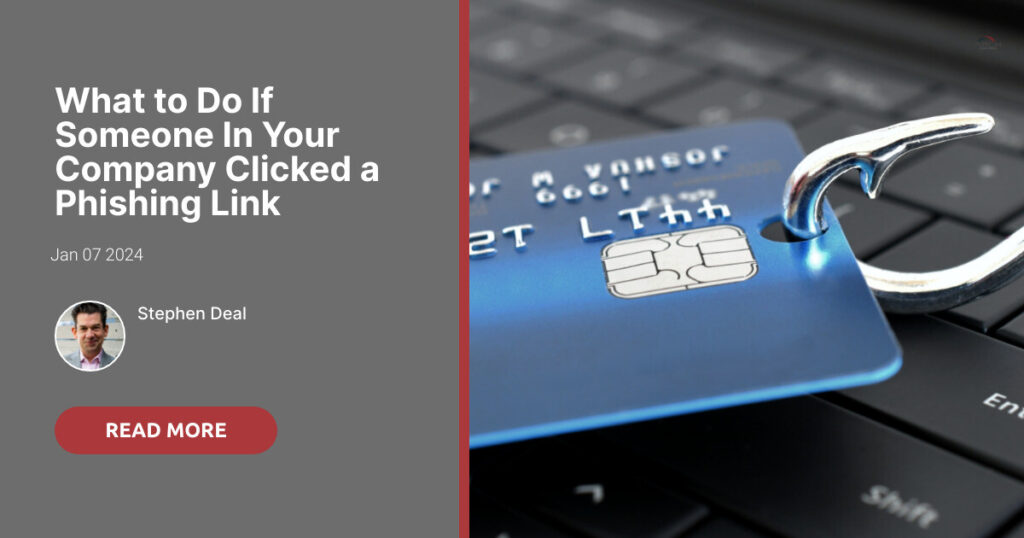
Phishing, a form of cyber deception where attackers masquerade as trustworthy entities to extract sensitive information, continues to evolve as a threat. Phishing is a popular technique for attackers because it’s relatively easy to create and distribute. If it’s successful, a phishing attack creates a way for attackers to bypass many of your defenses and start to gain access to your systems, and you should always take it seriously if one of your staff thinks they may have accidentally clicked on a link.
The key to mitigating the damage lies in how you respond to the incident. A prompt and effective reaction can mean the difference between a minor disruption and a major crisis. This article serves as a practical, step-by-step guide for businesses, outlining the essential actions to take if someone in your organization falls prey to a phishing link. Our goal is to equip you with the knowledge and tools to respond decisively, assess the situation accurately, communicate effectively, and implement measures to safeguard against future attacks.
Taking Immediate Action After a Phishing Incident
When someone in your company clicks on a phishing link, it’s like suddenly finding a small leak in a boat. Immediate action is crucial to prevent that leak from turning into a major breach. Here’s what you need to do right away:
- Isolate the Affected System: Think of this as containing the leak. The first step is to disconnect the affected computer from the network. This helps prevent the potential spread of malware or the leak of sensitive information to the hacker. It’s like putting a bucket under the leak to catch the water.
- Change Passwords and Secure Accounts: Next, change the passwords of any accounts that were accessed on the compromised device. This includes email accounts, company databases, and any other online tools or platforms used. If the phishing link was clicked through an email, ensure the email account’s password is changed immediately. Consider this step as patching up the hole in the boat.
Additionally, it’s important to:
- Enable two-factor authentication on accounts for an added layer of security.
- Review account settings for any unauthorized changes.
- Notify IT or Cybersecurity Team: Inform your IT or cybersecurity team about the incident as soon as possible. They can take more advanced steps to assess and mitigate the situation. This is like calling in a professional to make sure the leak is properly fixed and to check for any other potential weak spots.
Taking these immediate actions can significantly reduce the impact of a phishing incident.
Assessing the Damage
After you’ve taken immediate action to contain the potential fallout of a phishing attack, the next crucial step is to assess the damage. This is much like examining how much water the leak let into the boat and whether there are any other hidden damages.
- Understanding the Breach’s Extent: Work with your IT or cybersecurity team to determine what information may have been accessed or compromised. This could include confidential company data, employee personal information, or client details. This assessment is key to understanding the potential impact of the breach. Sometimes, just knowing the device that the person used to click the link can tell a lot about the risk. For example, clicking a link on the user’s personal mobile device has a much different risk profile than clicking a link on the computer your bookkeeper uses to process payroll.
- Checking for Malware or Ransomware: Often, phishing links are a gateway for malware or ransomware. Your IT team should conduct a thorough scan of the affected system to check for any malicious software that may have been installed. This is akin to checking for any other leaks or structural damage caused by the initial breach.
- Reviewing Access Logs: If possible, review the access logs of the affected accounts and systems. This can help identify any unauthorized access or actions taken by the attacker. It’s like looking back at the trail of water to see where it leads.
In assessing the damage, it’s crucial to:
- Stay organized and document everything that’s been found. This will be important for any future steps, including legal action or insurance claims.
- Be thorough in your assessment to ensure no aspect of the breach is overlooked.
Understanding the full scope of the damage is essential in formulating an effective response plan. It helps in deciding the next steps, such as notifying affected parties and taking measures to prevent such incidents in the future.
Communicating the Incident
Once you have a clear understanding of the breach’s impact, communication becomes a critical next step. It’s like informing your crew and passengers about the leak’s status and what’s being done to ensure their safety.
- Internal Communication: Start by informing your team about the incident, being transparent about what happened. Keep an eye out for any business processes that might be slowed or affected during the aftermath, like email access or payroll processing. Make sure to communicate the extent of the breach and the measures taken so far. It’s important to reassure them that the situation is under control and their interests are being protected.
- Informing Affected Parties: If your investigation determines that client data or external partner information was compromised, you must inform them as well. This can be a delicate conversation, so it’s crucial to be clear, concise, and honest. Offer details about the steps you’re taking to rectify the situation and prevent future incidents.
- Legal and Compliance Obligations: Depending on the nature and severity of the breach and the industry in which your business operates, you may have legal obligations to report the incident to regulatory bodies.
Good communication in the aftermath of a phishing attack can help maintain trust and mitigate potential reputational damage. It’s about being proactive, clear, and responsible in your messaging.
Preventive Measures and Training
The final step in navigating through a phishing incident is to strengthen your defenses to prevent future occurrences. This is akin to reinforcing the boat’s hull and training the crew for better emergency response.
- Enhancing Cybersecurity Measures: The best time to review your cybersecurity infrastructure and processes are up to date is six months ago. The next best time is today. While reviewing your cybersecurity protection might feel a little like closing the barn door after the animals have escaped, you are not immune from another attack after you recover from one, so get to this as soon as possible.
- Regular Employee Training: Phishing attacks often exploit human error. Conduct regular training sessions to educate your team on recognizing and responding to phishing attempts. Simulated phishing exercises can be an effective tool in this training.
- Creating a Response Plan: Develop a comprehensive incident response plan that outlines specific steps to be taken in the event of a cyber attack. This should include roles and responsibilities, communication protocols, and recovery processes. Looking for guidance on how to do this step? Our article on creating an effective incident response plan can help.
By implementing these preventive measures and focusing on training, you can significantly reduce your company’s vulnerability to future phishing attacks. It’s about being prepared and proactive, ensuring that your team and your systems are ready to handle any such challenges effectively.
Conclusion
Navigating a phishing incident requires swift action, careful assessment, effective communication, and strategic prevention. Each step, from isolating the affected system to enhancing overall cybersecurity training, plays a crucial role in managing the aftermath of a phishing attack. Even if you limit the damage from this attack you should still be using the experience to help you prevent the next one.
As you’ve seen from this article, the process for investigating and recovering from a phishing attack, as well as hardening your defenses so you aren’t as vulnerable to one in the future, is a lot of workArch Access is the trusted cybersecurity partner to help you implement best-in-class cybersecurity protections before an incident comes up, and we’re here 24/7 to help when things go wrong. Contact us at sdeal@archaccess.com to learn more.
FAQ
1. What immediate steps should be taken if someone clicks a phishing link?
- Isolate the affected system, change passwords and secure accounts, and notify your IT or cybersecurity team immediately. Swift action is crucial to minimize potential damage.
2. How can a company assess the damage after a phishing attack?
- Work with IT professionals to determine the extent of the breach, check for malware or ransomware, and review access logs to understand the scope of compromised information.
3. What are the best practices for communicating a phishing incident?
- Communicate transparently with your team and affected parties, outlining the incident’s extent and the steps being taken. Ensure compliance with any legal obligations for reporting the breach.
4. How can businesses prevent future phishing attacks?
- Enhance cybersecurity measures, conduct regular employee training on phishing awareness, create a comprehensive incident response plan, and foster a culture of cybersecurity vigilance.

